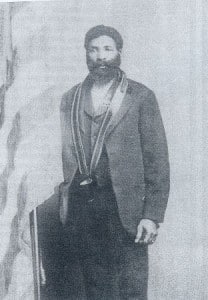African American History, Ask A Librarian, California History, People
Ask A Librarian: First African Americans in Napa
Who was the first African American in Napa County?
Although the long presence of peoples of African heritage in California is well-documented, it is difficult to know who the first to arrive in what was then known as “Nappa Valley” was. One claim to that distinction is George Washington. Historian Richard Dillon claims he was “loaned to the Canadians [in the Buenaventura Brigade, led by Alex McLeod] by an early Anglo-Californian ranchero, Abel Stearns…[Washington] had already been in California for six years. He knew the country and he spoke Spanish.”[i] The trouble with this theory is that Dillon is the only person to mention Washington, and since he cites no source for this claim, it remains unverified. The more likely claim lies with Anderson Norris. Norris was a cook on the sloop-of-war U.S.S Cyane. He jumped ship in Sausalito and fled north to Calistoga. According to Henry Fowler, an early settler in northern Napa Valley, Norris had joined up with some hunters before he was tracked down by Col. Vallejo.[ii] Vallejo executed Norris against the wishes of one white mountain man in particular, Ezekiel Merritt.

African Americans also arrived in California as slaves of white Americanos. In Napa, John Grider (sometimes Gryder) arrived with his owner, Major George H. Wyatt (sometimes Wyeth), in 1845. They came through Mexico in a party following Captain John Frémont, the man who would officially claim California for the United States the following year.[iii] On the heels of legal immigrants were the illegal ones: squatters, mountain men, and traders who came to California with little interest or regard for prior Mexican claims. A year after Grider and Wyatt arrived in Napa County, a group of brave American patriots – or a band of drunken hooligans, depending on which source one relies – stormed Mariano Vallejo’s Sonoma fort, arrested him and his brother, and captured the California. (One of those men was Ezekiel Merritt who still held his grudge against Col. Vallejo.) In brief, the rebellion was led by “American adventurers in California…[who sought] to take advantage of the deteriorating relations between Mexico and the United States and [were] fearful of repression of California’s Mexican authorities.”[iv]
Grider was one of eight Black men – including Jacob Dodson, James Duff, Charles Gains, Billy Gaston, Joe McAfee and a bodyguard named Ben – who participated in the Bear Flag Revolt, though how much they were involved in the planning and how willing they were to be involved in the rebellion in the first place is unknown. Grider was charged with obtaining paint for the rebel flag, and served as flag bearer in the revolt.[v] The rebellion lasted about a month before the Americanos declared victory. For the month of July 1846, California was an independent nation with its own president – William B. Ide, a , but once the United States and Mexico went to war, the revolutionaries had California brought in as a U.S. territory.
Some slaves did manage to pull themselves out of servitude. By 1850 John Grider had earned enough working at Murphy’s Diggings in the Southern Mines to purchase his and his mother’s freedom for $800. Caroline soon retired to Marysville, Yuba County.[vi] Wyatt, meanwhile, had just built the Central Hotel (also known as Wyatt’s Hotel) in Vallejo, with a livery and stable on Virginia Street. Grider took employment as hostler there, and outlasted several hoteliers. He was well-known locally as an excellent roughrider, and was regularly seen driving stages around town.[vii]
For many years he worked on various California ranches, usually with horses, and at one point even for a mulatto family, Henry and Charles Hannibal, near the Flemingtowne neighborhood in Vallejo. In the 1880s Grider shifted careers to work at Vallejo Steam Laundry. He retired in the late 1890s or early 1900s, but remained in Vallejo until his death in 1924.[viii] Unfortunately, his impact on local history remains mired in obscurity to the wider public even though he was admitted into the Vallejo Society of Pioneers, an organization requiring its members to have been in California before 1849.
[Ed. note: this article is excerpted in part from the master’s thesis “There Are No Black People in Napa”: A History of African Americans in Napa County by Alexandria Brown.]
[i] Richard Dillon, Napa Valley Heyday, (San Francisco: The Book Club of California, 2004), 48-49.
[ii] Rudolph M. Lapp, Blacks in Gold Rush California (New Haven, CT: Yale University Press, 1977): 5.
[iii] Sharon McGriff-Payne, John Grider’s Century: African Americans in Solano, Napa, and Sonoma Counties from 1845 to 1925, (Bloomington, Ind.: iUniverse, 2009): 19-20.
[iv] Charles Phillips and Alan Axelrod, “Bear Flag Revolt,” Encyclopedia of Wars (New York: Facts On File, Inc., 2005), http://www.fofweb.com.
[v] Delilah L. Beasley, Negro Trail-Blazers of California, (Los Angeles: Times Mirror printing and binding house, 1919): 33.
[vi] Ibid., 124.
[vii] McGriff-Payne, John Grider’s Century, 12-13.
[viii] Ibid., 14.

